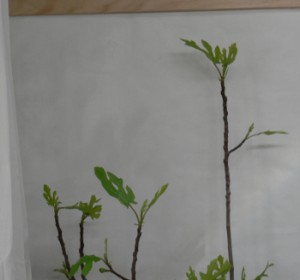
Up until I tasted figs fresh from my great aunt’s tree in Oceanside, California, my sole source of fig enjoyment had been Fig Newtons, which had never made me want to grow figs. My great aunt’s fresh figs, did.
One of the main reasons I had Solatube installed was to provide my fig with light, indoors. Solatube Project
Previously, from late February till May 10th when nights no longer pose a threat of freezing temperatures, I took my fig outside every morning and back in every evening. The fig’s huge pot is on a plant trolley which rolls easily on a flat surface ~ getting it over the door threshold was a twice daily challenge.
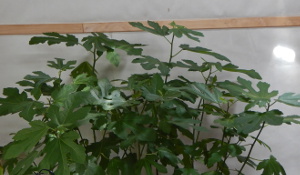
There are many little figs rewarding my effort ~~ though only one small fig, toward the picture’s lower edge, is showing.
Now, I wonder if my love of fresh figs comes from that wonderful sweet explosion of seeds when I bite into a fig, or if I love them because of the nutrition they provide.
Chart of Fig Nutrient Content
| Nutrient Content | |
| Protein | 0.5 |
| Total Fat | 0 |
| Vitamins | |
| A | 90.9 IU |
| C | 1.3 mg |
| E | 0.1 mg |
| K | 3.0 mcg |
| B - Niacin | 0.3 mg |
| B6 | 0.1 mg |
| Folate | 3.8 mcg |
| Pantothenic Acid | 0.2 mg |
| Choline | 3.0 mg |
| Minerals | |
| Calcium | 22.4 mg |
| Iron | 0.2 mg |
| Magnesium | 10.9 mg |
| Phosphorus | 9.0 mg |
| Potassium | 149 mg |
| Sodium | 0.6 mg |
| Zinc | 0.1 mg |
| Manganese | 0.1 mg |
| Selenium | 0.1 mcg |
| Sterols | |
| Phytosterols | 19.08 mg |
Potassium in Figs
Figs have quite a lot of potassium, a mineral proven to lower blood pressure and help regulate heart rate. Potassium is also known to reduce the likelihood of suffering a stroke. Read more about potassium.
Many online articles tout Figs as calcium-rich and therefore great for bone density and osteoporosis prevention, but what makes figs really attractive on the calcium front is that they contain a good balance of magnesium. Sadly, there’s a lot written about how great calcium is, without mention of an essential balance of magnesium so that the calcium goes to good use, rather than causing headaches or bone spurs. Read more about magnesium.
Figs contain chlorogenic acid
Just to be clear, chlorogenic acid has nothing to do with chlorine (bleach), but instead comes from the Greek for light green, which is the color it becomes when it oxidizes. Chlorogenic acids are powerful antioxidants that research has shown to lower blood pressure. That is, they have an “anti-hypertension” effect.
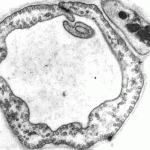
Chlorogenic acids, like those found in figs, as well as coffee, sunflower seeds, tea, blueberries, Chinese parsley, potatoes, tomatoes, apples, and eggplant, improve the function of endothelial cells, the thin layer of cells that line the entire circulatory system. Antihypertensive effects and mechanisms of chlorogenic acids, by Youyou Zhao, Junkuan Wang, Olivier Ballevre, Hongliang Luo and Weiguo Zhang.
Chlorogenic acid has anti-inflammatory properties that protect nerves and contribute to their health, according to research published in 2012 in the Brain Research Bulletin, Chlorogenic acid inhibits LPS-induced microglial activation and improves survival of dopaminergic neurons.
Dr. Vinson, who is big in the green coffee bean for weight loss movement, says that chlorogenic acid inhibits the release of glucose into the blood stream ~~ He hypothesizes that by slowing down the absorption of glucose in the bloodstream, chlorogenic acid reduces fat absorption. Dr. Vinson emphasizes that chlorogenic acid also functions to lower blood sugar with the result that it helps prevent diabetes.
Fig leaves in tea and dinner
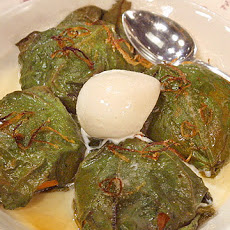
I was surprised to read that some cultures use fig leaves to lower the amount of insulin needed by diabetics. Really? People eat fig leaves? In a heartbeat Google provided me with several recipes, to include one by Martha Stewart ~ wrapping apricots in fig leaves (sans the stiff stem), baking, and serving with ice cream. Sounds really good!
There were other recipes for wrapping salmon and short ribs in fig leaves. Who knew?
Apparently a lot of people are less ignorant on this subject than me, and know that one of the most recognized health benefits of consuming fig leaves relates to their anti-diabetic properties. Fig leaves lower the amount of insulin required by the body, so that by eating fig leaves a diabetic reduces the need for insulin injections, which have often been a life-long and costly part of diabetes.
Diabetes Research and Clinical Practice published a study in 1998 showing that a decoction (tea boiled to concentrate it) of fig leaves reduced the need for insulin by 12%. Hypoglycemic action of an oral fig-leaf decoction in type-I diabetic patients. I would guess that without boiling to concentrate the properties, there would still be some benefit in relation to diabetes from drinking fig leaf tea.
In the same tea from fig leaves vein, some studies have shown that tea made from fig leaves is quite an effective home remedy for bronchitis and even asthma.
Figs and their phytonutrients
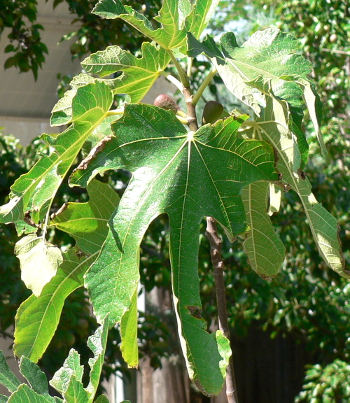
Figs, like all plants, produce phytonutrients to protect themselves from viruses, ultraviolet rays, pests, etc. A phytonutrient we commonly hear about is bioflavinoid. But, what is that, really?
Flavonoids in general are a broad class of compounds that are defined by their pigmentation, or in other words, color. The term “flavonoid” comes from the Latin word “flavus,” which means yellow. Thus, flavonoids applies to lemons, oranges, grapefruits, yellow figs, etc.
Flavonoids exert a multiplicity of neuroprotective actions within the brain, including a potential to protect neurons against injury induced by neurotoxins, an ability to suppress neuroinflammation, and the potential to promote memory, learning and cognitive function. The neuroprotective potential of flavonoids: a multiplicity of effects, David Vauzour, Genes and Nutrition, 2008.
Consumption of flavonoid-rich foods throughout life limits neurodegeneration and prevents or reverses age-dependent loses in cognitive performance. For this reason drug companies are intensely interested in flavonoids as a part of their quest for new drugs promising to enhance brain performance. Drug research has shown flavonoids to be beneficial in dementia, Alzheimer’s, and Parkinson’s. Keep in mind, the functionality of flavonoids is not dependent upon being made part of a drug, you can benefit from flavoids by eating fresh fruit and vegetables, preferably grown by you in your garden without the use of pesticides or RoundUp.
Dark purple figs, like blueberries, blackberries, purple grapes and plums, contain anthocyanins and phenolics which upon being eaten become antioxidants and contribute to anti-aging as well as helping to improve urinary tract health on one side of things, and memory function on another. Plus, they reduce the risk of some cancers.
The thing is, while we hear about certain phytonutrients, like bioflavonoids or phenolics, a fig contains 170 different ones ~~ That is the wealth of eating a wholesomely grown fig, or fruit of any kind, for that matter. That is the beauty of growing your vitamins!
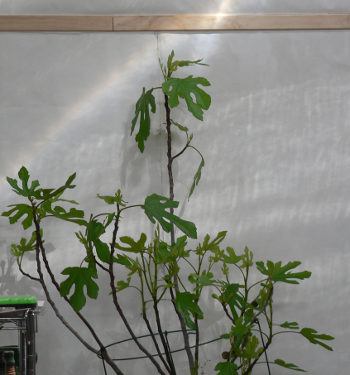
3/27/2014 ~ I have to add this picture of my fig enjoying the light from the newly added Solatube, which having been installed Level, is giving a wide band of light, in contrast to the old Solatube which sadly was not installed level and gives, as you can see in the first image on this page, a small fraction of the light.
Figs help fight cancer
One study of the polyphenolic compounds in figs was directed at learning to what extent eating figs, with their high levels of polyphenols, flavonoids and anthocyanins, helps us in fighting cancer cells. In the study’s introduction the researchers note that for decades natural products were regarded as important sources of chemotherapeutic agents, and impressively, 50% of anticancer drugs approved by the US Food and Drug Administration since 1960 originate with natural resources, particularly plants.
The study, which concentrated on fig latex applied to cancer cells in glass plates, showed that there was an antiproliferation effect on cancer cells by inducing apoptotic cell death. Apoptotic cell death is process of cell self-destruction that is marked by the fragmentation of nuclear DNA. Basically, figs provided a means to inhibit cancer cell DNA synthesis. Cytotoxicity of fig fruit latex against human cancer cells, 2007.
Fig latex used to cure warts
While eating figs is clearly different than collecting their latex and putting it on isolated cancer cells in a laboratory, or using it to cure common warts (a traditional method for treating warts in some rural areas of Iran uses fig tree latex applied to the wart ~ Fig tree latex therapy when studied showed several beneficial effects including that it worked quickly, there were no reports of side-effects. because it was easy it was attractive to patients and perhaps best of all, there was a low recurrence rate. The exact mechanism of the antiwart activity of fig tree latex is unclear but is likely to be the result of the proteolytic activity of the latex enzymes. Comparative study of fig tree efficacy in the treatment of common warts (Verruca vulgaris) vs. cryotherapy, International Journal of Dermatology, 2007.) there are several dozen studies showing figs to offer help against cancers of different kinds.
5/17/2014 ~ When I was moving my fig outside today, one of the leaves broke. I noticed a lot of latex, so I tried a little on a wart like thing on my eyelid. I’m curious to see if it has any affect. (or is it, effect?)
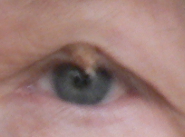 5/18/2014 ~ I remain curious to see if fig latex will work on the thing on my eyelid, which as been there, but not as big, for several years.
5/18/2014 ~ I remain curious to see if fig latex will work on the thing on my eyelid, which as been there, but not as big, for several years.
I broke another fig leaf off today, for the express purpose of applying its latex to the growth.
Having googled “growth on eyelid” I’ve found that it’s likely to be sebaceous keritosis, which is what I thought, especially since the top kept sloughing off for the first few years. Apparently they can turn into melanoma, so I’m glad I’ve increased my use of Milk Thistle, which is said to deprive growths like that of blood supply.
Upon further study it turns out that sebaceous keritosis is sometimes mistaken for melanoma, but does not lead to it. Prevalence of Melanoma Clinically Resembling Seborrheic Keratosis ~ Read more.
One of the most common eyelid growths is a stye. I had those when I was young. At some point I read that applying the inside of the skin of a potato, cut off thinly, to the stye was an effective stye cure. For sure that worked for me, and very quickly.
Several hour later ~ Pretty intense burning. Tried to wash off the latex, but that didn’t exactly work. I don’t have very good light in here, but with my lantern I could see that my eyelid above the growth was red and shiny, which I think must be from the latex brushing off on it and causing the burning sensation. I would guess the latex burns the sebaceous keritosis, as well, but I can’t feel that.
I used a small piece of paper towel with petroleum jelly on it to wipe the latex off my eyelid. It seems to have worked.
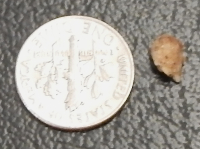
7/9/2014 ~ Well, I don’t know if the latex is what caused the thing to develop a hard outside and fall off, but fall off it did.
That doesn’t mean that my eyelid is perfectly normal where the thing was previously attached. On the contrary it looks as if another thing could form. I don’t know what will happen.
Just to be clear, it was hard to go on applying fig latex because my eyelids are droopy. So if I put latex on the thing, my eyelid would descend and get the latex on it, which I knew from experience would burn. Because of that I put latex on the thing about 4 or 5 times, and no more.
Figs contain plant sterols
Plant sterols have been known, for at least a century, to be distinct from cholesterol (chole-sterol). Because plant sterols are not absorbed and in fact interfere with cholesterol absorption, they have been investigated for over half century as a means of controlling high cholesterol and, plant sterols are among the oldest pharmacological therapies for high cholesterol (hypercholesterolemia).
Two of figs’ plant sterols are stigmasterol and lanosterol. These plant sterols have a proven beneficial effect on cholesterol. What they do is bind to molecules of cholesterol in the intestines and keep it from being absorbed.
Conclusion
If you like Fig Newtons, and haven’t tried fresh figs, Try fresh figs!!! ~~ You’re in for a treat. Then, think of how great it would be to have them growing in a container or in your yard… for their beauty and your convenience.
3/16/2014 ~ My fig dropped three of its leaves. Oh dear! Turns out, according to articles on the web, that the fig may be doing that because it needs more water. So, I’m giving it more water.
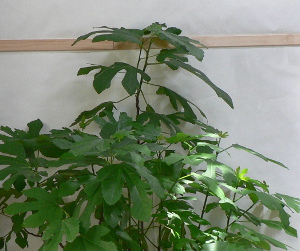
5/17/2014 ~ My fig became tall and lush, inside with Solatube light. This is the first year in Forever that I didn’t take it in and out, endlessly, from warm March days on through May when nights finally become warm enough not to freeze plants. The only problem is that I’m going to miss it inside. It gave this wonderful forest-feel to my living room.
Free Trials:
Try Amazon Music Unlimited 30-Day Free Trial
